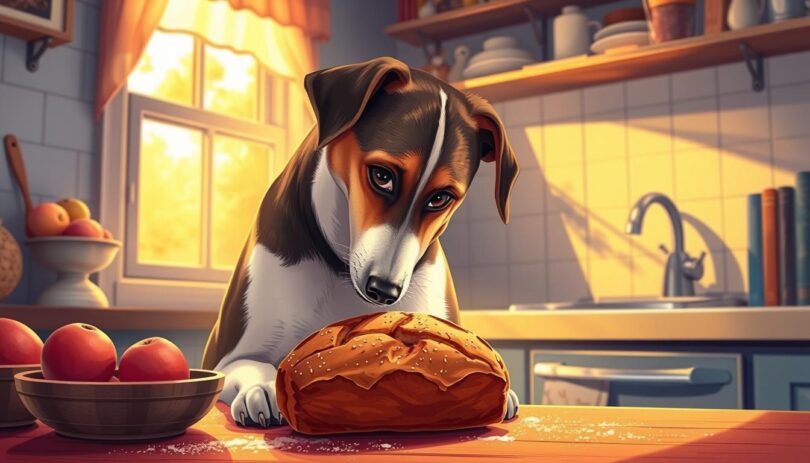Did you know 56% of pet owners admit to sharing human food with their pets regularly? While bread fills pantries worldwide, its role in canine diets sparks curiosity and concern. This article explores whether tossing a crust to your pup supports their health—or risks it.
Plain varieties like white or wheat bread are generally safe for most pets in tiny amounts. However, these carb-heavy snacks lack essential nutrients for a balanced diet. Veterinarians emphasize moderation, as overfeeding may lead to weight gain or digestive issues.
Not all baked goods are pet-friendly. Ingredients like garlic, raisins, or xylitol—common in some breads—pose serious toxicity risks. Owners must scrutinize labels before sharing even a crumb.
This guide breaks down nutritional facts, portion recommendations, and hidden dangers. You’ll learn how to treat your companion responsibly while prioritizing their wellbeing. Let’s separate fact from fiction about this everyday food’s place in dog bowls.
Exploring “can dogs have bread” and Its Safety Implications
Pet owners often debate whether sharing pantry staples with their companions is wise. While plain varieties like white or wheat bread aren’t inherently dangerous, they shouldn’t become dietary staples. Let’s unpack the core considerations for keeping treats both enjoyable and safe.
Understanding the Basics
Most pets tolerate small amounts of plain bread without issues. However, these baked goods offer minimal nutritional value compared to balanced meals. Overindulgence risks weight gain since many store-bought loaves contain added sugars and empty calories.
The Role of Moderation
Portion control proves critical when pets eat bread. A thumbnail-sized piece occasionally suffices for smaller breeds. Larger animals might handle slightly more, but never replace regular meals with carb-heavy snacks.
Watch for hidden dangers in commercial products. Some additives like garlic or raisins create toxic reactions in sensitive animals. Always check labels before sharing—what’s harmless to humans might endanger four-legged friends.
Nutritional Perspectives: Bread’s Place in a Dog’s Diet
Understanding bread’s role in a pet’s meals starts with its nutritional profile. While it might seem like a quick treat, its value depends on how it complements other dietary components.
Bread as a Filler Food
Most varieties act primarily as empty calories in a dog diet. They provide temporary fullness without delivering essential proteins or vitamins. Think of these baked goods like confetti—colorful but nutritionally insignificant compared to complete meals.
Caloric Content and Carbohydrates
A single slice of white bread contains roughly 70 calories and 13g of carbs. For smaller pets, this equals 5-10% of their daily energy needs. Frequent snacking disrupts energy balance, potentially leading to weight gain over time.
Veterinarians stress that treats shouldn’t exceed 10% of total food intake. While pets might eagerly eat bread, it lacks the fiber and nutrients found in quality kibble. Always prioritize balanced meals over carb-heavy indulgences.
Recognizing Hazardous Bread Ingredients
Baked goods often hide dangers that aren’t obvious at first glance. Pet owners must become label detectives, scanning for sneaky additives that could harm their furry companions. Common household breads sometimes contain toxic ingredients that trigger severe reactions in animals.
Ingredients That Pose a Risk
Raisins and garlic rank among the most dangerous additives. Even small amounts of raisins can cause kidney failure, while garlic damages red blood cells. Nuts like macadamia varieties create weakness and vomiting within hours of consumption.
Identifying Toxic Elements in Bread
Chocolate chips or cocoa powder in sweet breads contain theobromine, which overwhelms pets’ metabolism. Some artisanal loaves use xylitol—a sugar substitute linked to liver failure. Always check labels for these hidden threats before sharing leftovers.
Non-toxic ingredients like excess salt or butter can still cause digestive upset. Watch for panting, lethargy, or vomiting after accidental ingestion. When in doubt, contact your vet immediately—they’ll guide you through neutralizing risks.
Dangers of Raw Bread Dough for Dogs
Unbaked bread dough poses unique risks that cooked loaves don’t. The warm, moist environment of a pet’s stomach creates ideal conditions for fermentation. This process triggers two life-threatening reactions simultaneously.
How Yeast Affects a Dog’s Stomach
Active yeast in raw dough expands rapidly when swallowed. As it rises, gas builds up in the stomach, causing painful bloating. This pressure can twist the organ—a condition requiring emergency surgery.
Yeast also converts sugars into alcohol during fermentation. Even small amounts lead to alcohol poisoning. Symptoms like disorientation or trouble breathing may appear within 30 minutes.
Signs of Bread Dough Toxicosis
Watch for these critical warning signs after accidental ingestion:
- Distended abdomen or retching
- Loss of coordination or balance
- Unusual aggression or confusion
Vomiting or lethargy often signals alcohol toxicity. Seizures indicate advanced poisoning—rush to the nearest veterinary clinic immediately.
Never induce vomiting without professional guidance. Time matters: The Merck Veterinary Manual confirms that early intervention prevents 89% of fatal outcomes. Keep raw dough securely stored, and educate family members about these hidden hazards.
Safe and Unsafe Types of Bread for Your Dog
Pet parents often wonder which pantry staples make suitable occasional treats. While some varieties pass the safety test, others hide risks in their ingredient lists. Let’s explore which options support your companion’s health and which require caution.
Plain White and Wheat Bread: What’s Safe?
Basic white bread and simple wheat varieties typically pose minimal risks when served sparingly. These options lack spices, sweeteners, or additives that could upset sensitive stomachs. Their mild nature makes them preferable for pets with food sensitivities.
Nutritionists emphasize choosing whole-grain wheat bread over refined versions when possible. It offers marginally more fiber, though still falls short of being nutritionally complete. Always tear pieces into bite-sized portions to prevent choking hazards.
Breads to Avoid Due to Toxic Additives
Garlic bread tops the danger list—its seasoning damages red blood cells in animals. Butter-heavy options like brioche or croissants risk pancreatitis due to high fat content. Even small amounts of macadamia nuts in artisan loaves can cause weakness or vomiting.
Watch for these red flags on labels:
- Xylitol (common in sugar-free products)
- Raisins or currants
- Chocolate chips or cocoa powder
When sharing human foods, prioritize simplicity. Plain varieties without glazes or mix-ins offer the safest bet. If uncertain about ingredients, skip the snack and opt for vet-approved treats instead.
Moderation and Portion Control in a Dog’s Diet
How much is too much when sharing snacks with furry companions? While occasional treats can strengthen bonds, overindulgence risks long-term health consequences. Proper management ensures pets enjoy variety without compromising their nutritional balance.
Managing Dietary Intake
Treats like plain bread should never exceed 10% of daily calories. For a 20-pound pet, this equals roughly 40-50 calories—about half a slice. Larger animals might tolerate slightly more, but always prioritize nutrient-dense meals first.
Follow these guidelines to maintain healthy habits:
- Offer tiny pieces the size of a dice for smaller breeds
- Limit snacks to 2-3 times weekly at most
- Adjust regular meals if adding extra calories
Watch for signs like reduced appetite or stool changes after pets eat bread. These may indicate digestive discomfort or allergies requiring dietary adjustments. Always consult your vet if unusual symptoms persist.
Remember: Even safe foods become problematic in inappropriate amounts. By measuring portions and tracking frequency, owners prevent obesity while keeping treat time enjoyable. Balance remains the cornerstone of any thriving pet’s diet.
Practical Tips and Vet Advice for Feeding Dogs Bread
Responsible pet ownership means knowing when to act—and when to call the experts. While occasional treats might seem harmless, certain situations demand professional guidance.
When to Seek Veterinary Assistance
Contact your vet immediately if your pet shows these symptoms after eating bread:
- Vomiting or diarrhea lasting over 12 hours
- Lethargy or sudden loss of coordination
- Bloated abdomen from raw dough ingestion
Xylitol-containing products require urgent care—this sweetener causes rapid blood sugar drops and liver damage. Time matters: The ASPCA reports 70% of cases treated within 2 hours recover fully.
Monitoring Your Dog’s Health After Bread Consumption
Watch for subtle changes like excessive thirst or refusal to eat. Check gums for pale coloration, which could indicate toxicity. Adjust their next meal portions if they ate extra carbs.
Introduce new foods gradually—offer a pea-sized piece first. Wait 24 hours before increasing amounts. Always pair treats with balanced meals to maintain nutritional harmony.
Veterinary advice proves invaluable for pets with diabetes or allergies. Share your companion’s health history during consultations to get tailored feeding recommendations. Remember: Prevention beats treatment when managing dietary risks.
Final Thoughts on Bread Choices for Your Dog
Making informed choices about sharing pantry items with pets requires balancing curiosity with caution. Plain white or wheat varieties often pass safety checks in tiny amounts, but always verify ingredients first. Toxic additives like raisins, nuts, or xylitol turn innocent snacks into hazards.
Portion discipline proves vital—treats shouldn’t disrupt balanced diets. Watch for signs like vomiting or lethargy if pets eat bread containing questionable elements. Raw dough demands extra vigilance due to yeast expansion and alcohol risks in the stomach.
Consult your vet when introducing new foods, especially for animals with existing conditions. Keep these guidelines handy:
– Choose simple recipes without glazes or spices
– Store baked goods securely away from curious noses
– Prioritize vet-approved snacks for regular rewards
By combining ingredient awareness with measured feeding habits, owners protect their companions while enjoying occasional shared moments. Knowledge transforms simple gestures into acts of care.
FAQ
Is bread safe for dogs in small amounts?
Plain white or wheat bread without additives can be offered occasionally as a treat. Always avoid varieties containing raisins, garlic, macadamia nuts, or xylitol, which are toxic to pets. Moderation is key to prevent digestive issues.
What makes raw bread dough dangerous for pets?
Uncooked dough expands in the stomach due to yeast fermentation, causing bloating and discomfort. The process also produces alcohol, leading to toxicity. Symptoms like vomiting, lethargy, or seizures require immediate veterinary care.
Can garlic bread harm my dog?
Yes. Garlic contains compounds that damage red blood cells in dogs, potentially causing anemia. Even small amounts in seasoned breads pose risks—stick to plain varieties without herbs or spices.
How does bread affect a dog’s nutritional balance?
Bread offers minimal nutritional value and acts primarily as a filler. High carbohydrate content may contribute to weight gain if overfed. Always prioritize protein-rich meals tailored to your pet’s dietary needs.










Leave a Comment